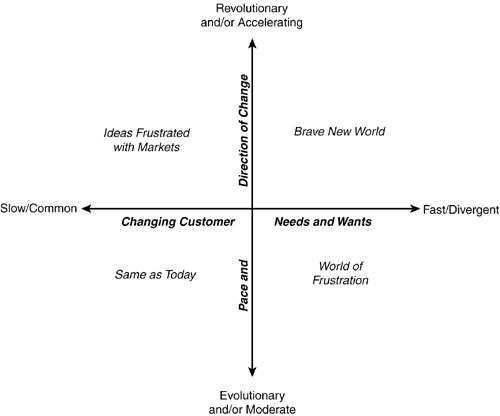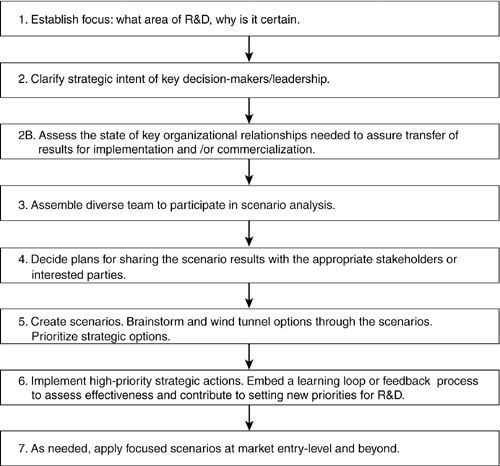Chapter 23. The Effective Use of Scenario Analysis to Support Research and Development
Peter Schwartz and Gerald Harris
Introduction
During the past 5 years, we have worked with companies interested in applying scenario analysis techniques to their research and development (R&D) plans over the medium-to-long term (generally 5-year to 10-year timeframes). These engagements involved companies in a range of industries—computer hardware and software, telecommunications, and power generation—as well as people in various roles from business development and marketing executives to pure researchers, engineers, and scientists. Based on our experience, we have identified a number of best practices that produce the most useful results. They include
- Involve a diverse team of people and perspectives.
- Put a "stake in the ground." (In other words, take into account that which senior management or key decision makers consider as vital aspects of the company's strategic intent—the company's vision or sense of "who it wants to be."
- Maintain openness about the uncertainty of customer needs and wants.
- Make the path from ideas to the creation of products and services clear by incorporating a strong technology roadmap.
- Establish a well-functioning connection between R&D and business development, marketing, and manufacturing departments.
- Embed a continuous learning loop and focused scenario analysis at the market entry point and beyond.
Using Scenario Analysis to Guide R&D Planning
The purpose of R&D is to enhance the product and service offerings of a company. This may mean incremental or revolutionary improvements to current products as well as the introduction of completely new offerings. However, in a successful business, R&D is not solely the job of the technical people who sit in the laboratory, invent things, and throw them over the wall. Superior R&D requires a connection to customer needs and desires and to how products and services might be priced, positioned, and sold relative to the competition. This is a complex process involving many people with different roles and priorities, which inevitably gives rise to communication challenges.
It is in managing such communication challenges that scenario analysis techniques can provide real value. A diverse team of people, drawn from across the organization and seeded with knowledgeable outsiders (maybe even customers), can open up the strategic conversation about the intent and direction of R&D spending. In other words, it is useful to bring together key stakeholders from marketing, customer relations, business development, and finance as well as R&D to ask a broader set of questions: What is R&D trying to achieve, and over what timeframe? What will enhance competitiveness? How will it support meeting important aspects of the customer's total value proposition? The R&D department's technical staff cannot answer these questions alone. A well-managed scenario analysis provides a process through which diverse stakeholders can explore the uncertainties behind these questions in an open and learning-oriented way. Ultimately, this can generate exciting new insights, deepen the shared understanding of R&D decision making, and build lasting, cross-organizational relationships.
A Common R&D Scenario Framework
To explain more about scenario analysis in R&D, we will share a scenario framework that arose consistently in our work. In developing scenarios, it is useful to establish the framework by isolating two highly uncertain, but very important, variables that may drive change in the future. In our R&D work, we found two recurring variables: (1) the pace or direction of technology innovation, and (2) changes in customer needs or wants. In most cases, the scenario teams felt that the underlying technology (or technologies) they were working with could either accelerate or stagnate, be open to sudden breakthroughs, be shifted by wildcards, or be largely out of their control. Despite edicts to "know thy customer," the teams felt that customer demand could be fickle—affected by competitive offerings, substitutes, economic conditions, peer pressure, and a host of other factors. This typically led to different versions of the scenario framework displayed in Figure 23.1.
Figure 23.1. Scenario framework.

This framework was only a starting point for detailed and well-researched scenarios. Its strengths lay in the divergent and challenging worlds that each quadrant suggests. Typically, the northeast quadrant produced a "Brave New World" scenario, where many big changes—and opportunities—challenged companies to keep up and to innovate. The southwest quadrant, by contrast, tends to produce scenarios with a "same-as-today" feeling; participants were either satisfied that their companies were well positioned or frustrated that a lot of good ideas would go undeveloped. Scenarios for the southeast and northwest quadrants seemed counterintuitive, and the teams found that making them work in the real world was challenging and exciting. The southeast quadrant typically involved a "world of frustration," as customer needs went unmet and a series of inadequate solutions were tried and usually failed. In the northwest quadrant the scenario was often a variation on "ideas frustrated with markets"—participants worried that new technologies would not match customer needs and wants and therefore wouldn't find profitable markets. In many cases, the southeast and northwest quadrants introduced unexpected, but plausible, real-world contradictions into the conversation.
Elements of a Good Scenario Analysis
Whether scenarios are developed to guide R&D plans or to inform other strategic decisions, a number of basic steps should be followed. Once a divergent and sound (well-researched, convincing) set of scenarios is created, they should be used to test, or "wind-tunnel," existing strategies—what the organization is actually doing or positioning itself to do in the areas of concern. Then, the scenarios should be used to create new strategic options. In order to do this, members of the stakeholder team should "live" in each scenario—assume it is true—and determine what strategies or actions might lead to success. Then, the options for each scenario should be tested for robustness: Do some work in all scenarios? Those that are robust should become high priority. Those that are not, but have great appeal if certain events unfold, should be looked at closely in two ways. First, are there low-cost and low-risk actions that the stakeholder team can take that will allow the organization to quickly move to this option? Second, can the team identify and scan for early indicators that give a signal to move that option to the forefront? Making strategy development proactive rather than reactive, and dynamic instead of static, is among the most valuable dimensions of scenario analysis.
Getting the Most from R&D Scenarios
In our experience, a strong, well-facilitated team will create challenging and useful scenarios. The real differences lie in the level of participation and in how the scenarios are ultimately used and shared within the organization, as demonstrated by the following three examples.
In one of our most successful cases in the telecommunications industry, a joint team from business development and R&D initially requested the scenarios. This team worked together throughout the process and at a key point introduced and wind-tunneled a technology roadmap through the scenarios. The conversation exploded with insights and ideas. The team was able to pinpoint specific technical advances that would support high value-added or competitive product features specific to each scenario. The path to commercializing products was also made clearer and more concrete. Importantly, this team enjoyed clear senior management support and direction, including an attitude that there were no failures. Instead, if a chosen path didn't succeed in meeting its objectives, there was still an opportunity to capture the learning for future efforts. The 5-year timeframe for evaluating results allowed the team to be patient, and the scenarios provided the context for deeper, more focused analysis. Years after we concluded the project, focused scenarios were used to consider pathways to market entry.
In a moderately successful effort, a company involved in heavy manufacturing succeeded not so much in radically shifting the direction of R&D spending, but in getting a wide range of parties involved. As a result, the ultimate decisions were well understood and supported across the organization. Relationships were built internationally across several groups. Finally, the team isolated some key uncertainties for longer term scanning and monitoring that could portend a change in direction. This project would have been much more valuable if there had been deeper research on and openness toward changing customer needs and wants. Integrating more customer perspectives would have added more content in the strategic option development stage of this project.
Our least successful effort involved a consortium of companies and resulted, we feel, from confusion and a lack of cohesion around the strategic intent of the key stakeholders. These companies were mostly involved in computers and information technology, and fit in different places along the value chains of those industries. In this situation, R&D results had to be shared with multiple and sometimes competing firms. Competitive concerns kept many participants from being explicit about their true strategic interests and made it impossible to test existing or potential strategies within the context of the scenarios. Eventually, this handicapped the lead organization's ability to articulate viable options and share results. However, this project did have a powerful impact in terms of using the scenario-development process as a tool for sharing perspectives across a diverse group. Many participants expressed appreciation at the opportunity to see how companies at various points in the industry value chain perceive issues and problems differently. Based on these and similar projects, we recommend following the process map (shown in Figure 23.2) in order to ensure that scenario analysis is successfully applied.
Figure 23.2. Process map for applying scenario analysis to R&D planning.

Conclusion
In conclusion, scenario analysis can enhance and guide R&D efforts by engaging a broader range of stakeholders; leveraging their experience and knowledge to create divergent and challenging future worlds that illuminate risks and opportunities; and creating a context for evaluating existing and potential strategies in an uncertain world. Ultimately, scenario analysis can enrich the organization's ongoing strategic conversation about the purpose and increasing importance of forward-looking research, development, and innovation.
